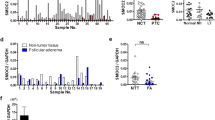Abstract
Ubiquitin-specific protease 22 (USP22), a novel deubiquitinating enzyme, has been associated with metastasis, therapy resistance, and cell cycle progression. The purpose of this study was to investigate the expression level of USP22 in papillary thyroid carcinoma (PTC) samples and to evaluate its clinical significance in PTC patients. USP22 expression was examined in 30 fresh PTC tissues and paired adjacent noncancerous tissues by real-time quantitative RT-PCR. Immunohistochemistry for USP22 was performed on additional 156 PTC tissues. The clinical significance of USP22 expression was analyzed. We found that the expression levels of USP22 mRNA and protein in PTC tissues were both significantly higher than those in noncancerous tissues. Clinicopathological analysis showed that USP22 expression was significantly correlated with tumor size (p = 0.036), extracapsular invasion (p = 0.012), multifocality (p = 0.014), lymph node metastasis (p = 0.022), distant metastasis (p = 0.005), and TNM stage (p = 0.002). The Kaplan–Meier survival curves revealed that USP22 expression was associated with poor prognosis in PTC patients. USP22 expression was an independent prognostic marker of overall patient survival in a multivariate analysis. Our findings suggest that USP22 is an independent predictor of poor prognosis of PTC patients.



Similar content being viewed by others
References
Davies L, Welch HG. Increasing incidence of thyroid cancer in the United States, 1973–2002. JAMA. 2006;295:2164–7. doi:10.1001/jama.295.18.2164.
Hay ID, Thompson GB, Grant CS, Bergstralh EJ, Dvorak CE, Gorman CA, et al. Papillary thyroid carcinoma managed at the Mayo Clinic during six decades (1940–1999): temporal trends in initial therapy and long-term outcome in 2444 consecutively treated patients. World J Surg. 2002;26:879–85.
Glinsky GV. Death-from-cancer signatures and stem cell contribution to metastatic cancer. Cell Cycle. 2005;4:1171–5.
Glinsky GV. Genomic models of metastatic cancer: functional analysis of death-from-cancer signature genes reveals aneuploid, anoikis-resistant, metastasis-enabling phenotype with altered cell cycle control and activated Polycomb group (PcG) protein chromatin silencing pathway. Cell Cycle. 2006;5:1208–16.
Glinsky GV, Berezovska O, Glinskii AB. Microarray analysis identifies a death-from-cancer signature predicting therapy failure in patients with multiple types of cancer. J Clin Invest. 2005;115:1503–21. doi:10.1172/JCI23412.
Zhang XY, Varthi M, Sykes SM, Phillips C, Warzecha C, Zhu W, et al. The putative cancer stem cell marker USP22 is a subunit of the human SAGA complex required for activated transcription and cell-cycle progression. Mol Cell. 2008;29:102–11. doi:10.1016/j.molcel.2007.12.015.
Zhao Y, Lang G, Ito S, Bonnet J, Metzger E, Sawatsubashi S, et al. A TFTC/STAGA module mediates histone H2A and H2B deubiquitination, coactivates nuclear receptors, and counteracts heterochromatin silencing. Mol Cell. 2008;29:92–101. doi:10.1016/j.molcel.2007.12.011.
Bouchard C, Dittrich O, Kiermaier A, Dohmann K, Menkel A, Eilers M, et al. Regulation of cyclin D2 gene expression by the Myc/Max/Mad network: Myc-dependent TRRAP recruitment and histone acetylation at the cyclin D2 promoter. Genes Dev. 2001;15:2042–7. doi:10.1101/gad.907901.
Feinberg AP, Tycko B. The history of cancer epigenetics. Nat Rev Cancer. 2004;4:143–53. doi:10.1038/nrc1279.
Jones PA, Baylin SB. The epigenomics of cancer. Cell. 2007;128(4):683–92. doi:10.1016/j.cell.2007.01.029.
Stephen JK, Vaught LE, Chen KM, Sethi S, Shah V, Benninger MS, et al. Epigenetic events underlie the pathogenesis of sinonasal papillomas. Mod Pathol. 2007;20:1019–27. doi:10.1038/modpathol.3800944.
Giannattasio M, Lazzaro F, Plevani P, Muzi-Falconi M. The DNA damage checkpoint response requires histone H2B ubiquitination by Rad6-Bre1 and H3 methylation by Dot1. J Biol Chem. 2005;280:9879–86.
Lee HJ, Kim MS, Shin JM, Park TJ, Chung HM, Baek KH. The expression patterns of deubiquitinating enzymes, USP22 and Usp22. Gene Expr Patterns. 2006;6:277–84.
Ingvarsdottir K, Krogan NJ, Emre NC, Wyce A, Thompson NJ, Emili A, et al. H2B ubiquitin protease Ubp8 and Sgf11 constitute a discrete functional module within the Saccharomyces cerevisiae SAGA complex. Mol Cell Biol. 2005;25:1162–72. doi:10.1128/MCB.25.3.1162-1172.2005.
Lv L, Xiao XY, Gu ZH, Zeng FQ, Huang LQ, Jiang GS. Silencing USP22 by asymmetric structure of interfering RNA inhibits proliferation and induces cell cycle arrest in bladder cancer cells. Mol Cell Biochem. 2011;346:11–21. doi:10.1007/s11010-010-0585-4.
Guney I, Wu S, Sedivy JM. Reduced c-Myc signaling triggers telomere-independent senescence by regulating Bmi-1 and p16(INK4a). Proc Natl Acad Sci U S A. 2006;103:3645–50. doi:10.1073/pnas.0600069103.
Acknowledgments
This study was supported from the National Natural Science Foundation of China (grant no. 81101504 and 81000937).
Conflicts of interest
None
Author information
Authors and Affiliations
Corresponding authors
Additional information
Hui Wang, Yong-Ping Li, and Jiang-Hao Chen contributed equally to this paper.
Rights and permissions
About this article
Cite this article
Wang, H., Li, YP., Chen, JH. et al. Prognostic significance of USP22 as an oncogene in papillary thyroid carcinoma. Tumor Biol. 34, 1635–1639 (2013). https://doi.org/10.1007/s13277-013-0696-0
Received:
Accepted:
Published:
Issue Date:
DOI: https://doi.org/10.1007/s13277-013-0696-0




